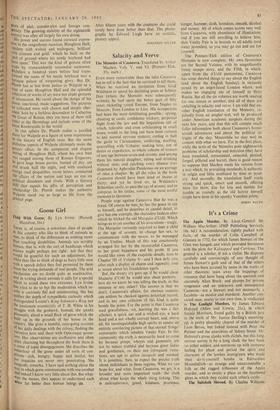Goose Girl
THERE is, of course, a notorious class of people in this country who like to think of animals as Inert, to think of the differences as nothing more than touching disabilities. Animals are terribly human, that is, with the sort of handicaps which science might perhaps put right : not that they would be grateful for such an adjustment, for While they like to think of dogs as hairy little men With a speech defect they feel protected by them from the trying demands of real people. The arid Mechanists are no doubt quite as unattractive, and in writing about animals it calls for a special talent to avoid these two extremes. Lyn Irvine has tried to do so but the moderation which re- sults is curiously flat and uninteresting. She has neither the depth of sympathetic curiosity which distinguished Lorenz's King Solomon's Ring nor the passionate eccentricity of T. H. White in his struggle with the goshawk. Instead, she speaks Pleasantly about a small flock of geese which she built up in the grounds of her house in the country. She gives a tasteful, easy-going account of her daily dealings with the colony, fleshing the narrative here and there with Opie-esque goose- lore. Her observations are inoffensive and often "he charming but throughout the book there is sense of tepid disengagement. She describes the behaviour of the geese under all sorts of con- ditions—sick, hungry, happy and lustful, but Crp inquiries are never very penetrating. She languidly remarks, 'I have said nothing about the WaY in which geese communicate with one another and indeed I know very little about this. But what- ever the means, they appear to understand each other far better than human beings do. . .
After fifteen years with the creatures she could surely have done better than that. The photo- graphs by Edward Liegh have an ecstatic, plumey appeal.
JONATHAN MIL LER


































 Previous page
Previous page